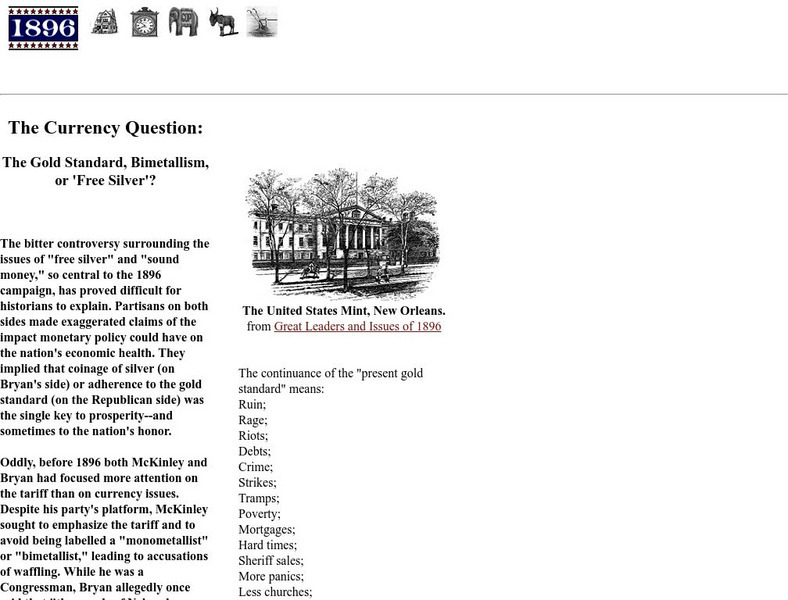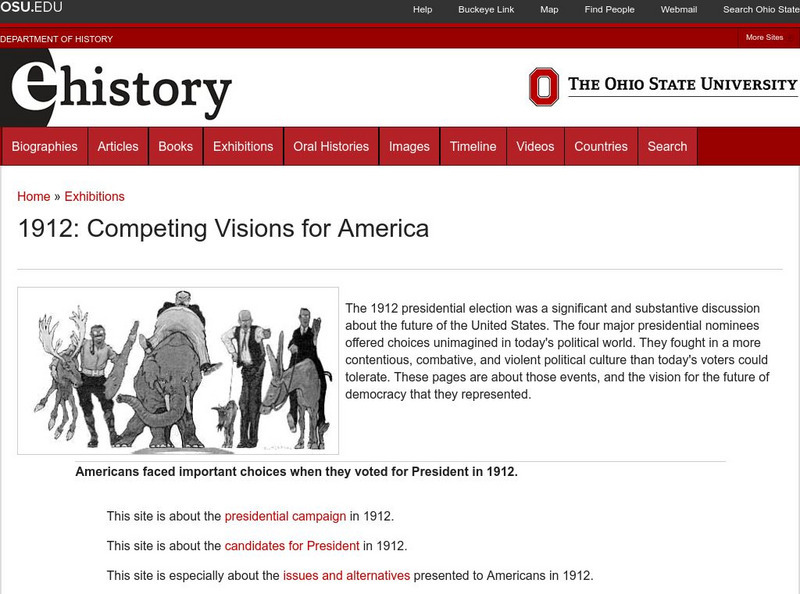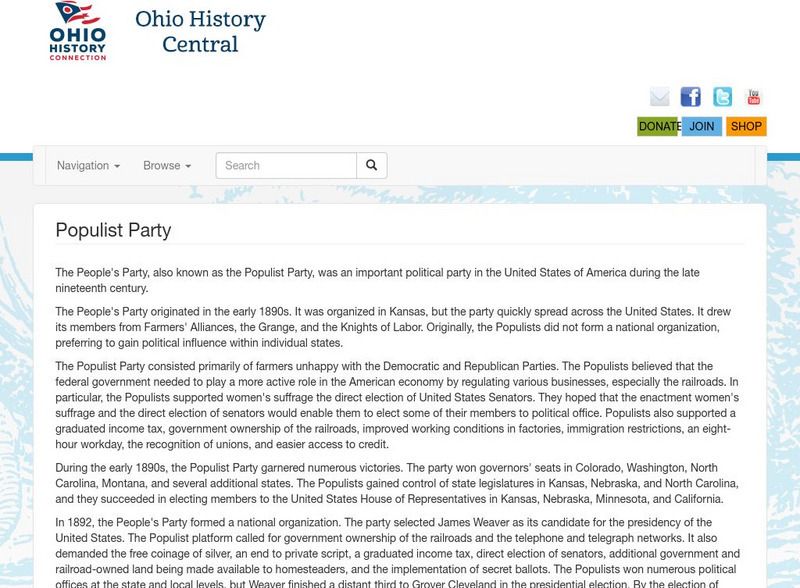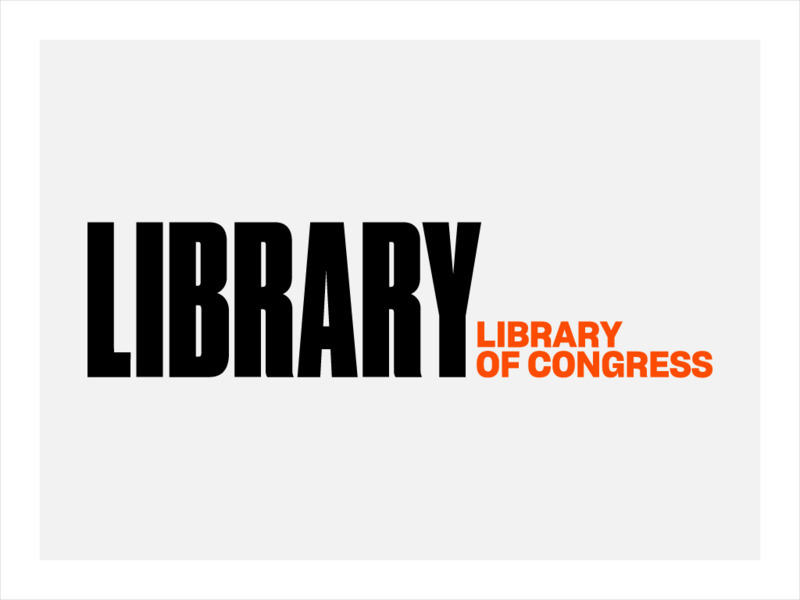PBS
Pbs Learning Media: Meet the 2016 Presidential Candidates: Lesson Plan
In this lesson, learners will get to know the candidates running for president and where they stand on important issues. They will create a flow chart documenting the steps a candidate must take to be elected. Then they will conduct...
Other
Communist Party of Canada (Marxist Leninist)
Canada has an open and democratic electoral system. There are a variety of political parties officially recognized by Elections Canada that have roots in non-democratic traditions. Nevertheless, in Canada, this parties are free to offer...
Digital History
Digital History: The Presidency of Andrew Jackson
The campaign of 1828 was heated and bitter. Read about the man who was elected, Andrew Jackson, his background, and the basis of his administration.
Vassar College
Vassar College: 1896: The Currency Question: The Gold Standard
This site is provided for by the Vassar College. "The bitter controversy surrounding the issues of `Free silver' and `sound money,' so central to the 1896 campaign, has proved difficult for historians to explain." However, this 1896, a...
Vassar College
1896: The Republican Party
From the comprehensive Vassar College project about the politics of 1896, this article relates the state of the Republican Party in that year and its party platform for the election of 1896.
Wikimedia
Wikipedia: United States Presidential Election, 2004
Wikipedia provides information on the 2004 presidential election. It gives a list of the presidential candidates by political party, a month-by-month timeline of events pertaining to the 2004 campaign, electoral college changes since the...
Other
Fieldston School United States History Survey: Rugged Individualism Speech
Herbert Hoover closed his 1928 presidential campaign with this speech, an expression of the Republican Party's philosophy of rugged individualism.
NPR: National Public Radio
Npr: Election 2008
NPR's page on Election 2008 includes various stories on the political candidates, the election and an interactive map of primaries and caucuses as well as follow-up reports.
Ohio State University
E History: 1912: Competing Vision for America
An evaluation of the 1912 Presidential election. Shows the competing viewpoints at this time in American history and the different aspects of the 1912 election. Click on the other links to learn more about the election through political...
PBS
Pbs Learning Media: What Is Social Media's Role in Election 2016?
In this lesson, students examine the different ways candidates use social media, including Instagram, Facebook, and Twitter in their presidential campaigns. They will watch videos, read articles, and examine candidates' social media pages.
Ohio History Central
Ohio History Central: Populist Party
The Populist Party was one of the more successful third parties, at least in state politics. Read about its platform on the national and state levels in the 1890s.
Harp Week
Harp Week: The Presidential Elections: 1880 Cartoon List
This fabulous site compiles political cartoons from Harper's Weekly for the campaing of 1880. The cartoons are drawn by Thomas Nast, and each cartoon is thoroughly explained. A great resource.
University of Groningen
American History: Outlines: Agrarian Distress and the Rise of Populism
Article outlines the rise of the Populist Movement in the U.S. as a result of a declining economy, agrarian distress and dissatisfaction with American politics in late 19th Century.
University of Maryland
University of Maryland: For All the World to See: Emory Douglas
Emory Douglas led a graphic visual campaign expressing the story of the Black Panther Party.
University of Virginia
Miller Center at Uva: u.s. Presidents: Franklin Pierce: The American Franchise
Read about the political party leanings of immigrants in the 1850s and the backlash against immigrants as reflected in political platforms.
A&E Television
History.com: How the South Helped Win the American Revolution
British commanders attempted to reverse their floundering fortunes by launching a campaign in the South. There the British would find not just crops such as tobacco, rice and indigo that were vital to their economy, but stronger Loyalist...
Curated OER
National Park Service: Biographical Sketches: Warren Harding
This concise article about Warren G. Harding gives information about his early life, how he got into politics, and his election as 29th president. There is brief mention of his domestic and foreign policies.
Vassar College
Vassar College: 1896: The Populist Party
This great resource from 1896, A Website of Political Cartoons from Vassar College discusses "The Rise of Populism" to "The End of Populism--or Not?"
University of California
The History Project: Ideas and Strategies of the Woman Suffrage Movement
The campaign for woman suffrage in the U.S. began with the Seneca Falls Convention in 1848. Sixty years later, however, women could vote in only four states: Colorado, Utah, Idaho and Wyoming. In 1910 the state of Washington voted nearly...
New York Times
New York Times: On This Day: Electoral College Controversy 1876
Thomas Nast's political cartoon from a Harper's Weekly 1877 edition plus a description of the dispute over the election of 1876.
A&E Television
History.com: How Us Presidents Have Communicated With the Public From the Telegraph to Twitter
From carefully staged speeches to radio to Twitter, U.S. presidents have always leveraged the cutting edge to connect directly with voters. Two centuries before Twitter, U.S. presidents understood the power of communicating directly with...
Other
Landmark Cases: United States v. Nixon (1974)
This is a great resource for teaching about this key Supreme Court case that dealt with the issue of executive privilege, and became known as the Watergate Scandal. Included is the complete text of the opinion.
Library of Congress
Loc: Primary Source Set: Women's Suffrage
A collection of primary sources dealing with women's suffrage.
Other
I Side With: 2016 Presidential Election: Quiz
Website designed to help voters decide which candidate best supports their interests. Students can take a quiz to find out their affiliation.















